Omnichannel Personalization in eCommerce: Unifying Website, Catalog, Email & SMS
Marketers know that winning customer hearts (and wallets) takes more than a one-time ad or a standard promo email. It’s about creating a smooth, personalized journey across every touchpoint, from browsing your website to the products you recommend, to the emails and SMS messages that follow up. When done right, it feels like one continuous conversation. When done wrong, it feels disjointed (and customers drop off). In this blog, we’ll explore how website personalization and product recommendations powered by an Agentic co-marketer can work with email and SMS to form a seamless customer journey. We’ll use Sephora, a brand that aces omnichannel personalization - as our example, and show how you can achieve this too (without the enterprise techstack headache). Let’s dive in!



Expected Results
- Build a unified cross-channel journey that feels like one conversation (web → email → SMS → in-store).
- Combine segment-based personalization (who the user is) with catalog-based recommendations (what they want).
- Trigger real-time, personalized follow-ups across website, email, and SMS.
- Lift customer engagement, repeat purchase rate, and LTV through cohesive personalization.
Why Does a Seamless Cross-Channel Journey Matter?
When channels don’t talk, customers walk. Imagine a customer who has a tailored experience on your site, but then receives a completely unrelated email offer -jarring, right? Consistency is key. Brands that connect the dots between web, email, and SMS enjoy big benefits. For instance, companies with strong cross-channel marketing strategies achieve 89% customer retention on average (versus only 33% for weaker multichannel efforts).
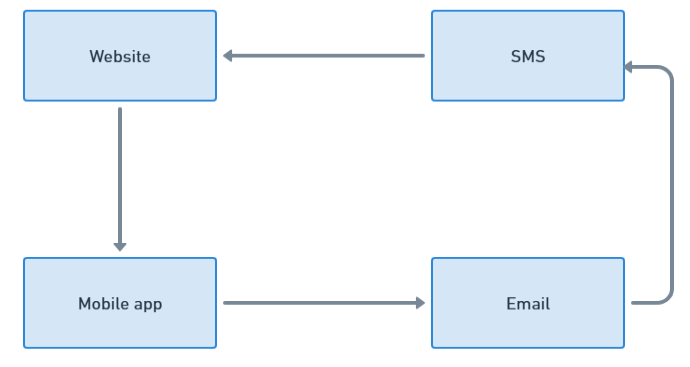
When every channel reflects what the customer just did or is likely to do next, the experience feels natural - like one continuous conversation.
- Website → Email/SMS: Recommendations and messages reflect browsing or purchase behavior.
- Email/SMS → Website: Deep links land users back on personalized experiences.
- Store → App/Web: Loyalty data flows both ways, ensuring in-store actions update digital personalization.
Customers reward this harmony with higher engagement and repeat orders.
The Personalization Formula:
Personalization has two engines:
1. Segment-Based Personalization (the “who”)
This approach targets “who” the user is (or what group they belong to) to tailor the experience. It uses user attributes and behaviors to create segments and predictive scores. For example:
- RFM Segmentation: Grouping users by Recency, Frequency, and Monetary value of purchases. This helps identify lifecycle segments like “Champions” (most loyal customers), “At Risk” (previously good customers now fading), “New Customers,” etc. Each segment gets different treatment. (Is a shopper high-value and recent? Roll out the red carpet with exclusive offers. Lapsed? Send a win-back offer.)
- Next Best Action Predictions: Using AI to predict what a user is most likely to do (or need) next, and tailoring offers or content for that. For example, if a customer has a high likelihood to churn vs. to purchase, the next best action will differ (perhaps a retention offer vs. a personalized item offer). This ensures you’re always guiding them optimally, not blindly.
- Behavioral & Profile Attributes: These include things like product category preferences (e.g., beauty shopper interested in skincare vs. makeup), brand affinity, location, retention tier, etc. With the help of AI, segmenting such attributes lets you show relevant content for your customers that boosts customer retention.
(For eg, if Jane consistently browses skincare, your homepage banner could highlight the latest in skincare for her, not the standard top sellers in all beauty.)
2. Catalog-Based Recommendations (the “what”)
This focuses on “what” products or content to show each user, usually via algorithmic recommendations. It leverages your product catalog data and user behavior. Key recommendation types include:
- Affinity Recommendations: Items related to the user’s previously demonstrated interests. For example, if Sephora Jane has shown an affinity for K-beauty skincare products, the site might recommend other K-beauty skincare items or new arrivals in that category. These recs align with her personal tastes.
- Similarity Recommendations (Content-Based): Showing similar items to those the user viewed or purchased recently. (“Liked that face serum? Here are similar serums or products with comparable ingredients.”) This helps customers discover products in the same style. Intempt provides AI-enabled recommendations based on customer preferences in real time.
- Collaborative Filtering: “Customers who bought X also bought Y.” This mines the wisdom of the crowd. If many people with similar behavior as Jane ended up buying a certain product, it’s likely relevant to her too. Classic examples are the “Frequently Bought Together” or “You Might Also Like” sections on product pages. Sephora uses this by suggesting items that pair well with what’s in your basket (e.g., a primer to go with the foundation you’re viewing).
Using both personalization layers together is where the magic happens ✨. Segment-based rules set the stage (who is this user and what do they need?), and recommendation algorithms fill in the specific (which products or content?).
For example, if a user is in the “At Risk” segment (hasn’t purchased in a while), your site might automatically show a banner like - “We miss you! Here’s 10% off on items picked for you”. The products shown in that banner would be generated by a recommendation engine -perhaps a mix of items related to their past favorites (affinity) or popular sale items to entice them.
On-Site Personalization: Every Visit Feels Like “Made for Me”
Your website (or mobile app) is where the journey typically starts. Here’s how segment-based personalization and product recommendations unite to make each visit feel bespoke:
- Personalized Content & Layout: Depending on the visitor, you might change hero banners, headlines, and even calls-to-action with the help of AI. Example: Sephora’s site might greet a logged-in Beauty Insider loyalty member with a “Welcome back, [Name]! Your 500 points can get you a free gift 🎁” message, whereas a first-time visitor sees a standard welcome or a sign-up offer. If you know a user’s favorite category is “fragrance,” the homepage could prominently feature a perfume promotion for them.
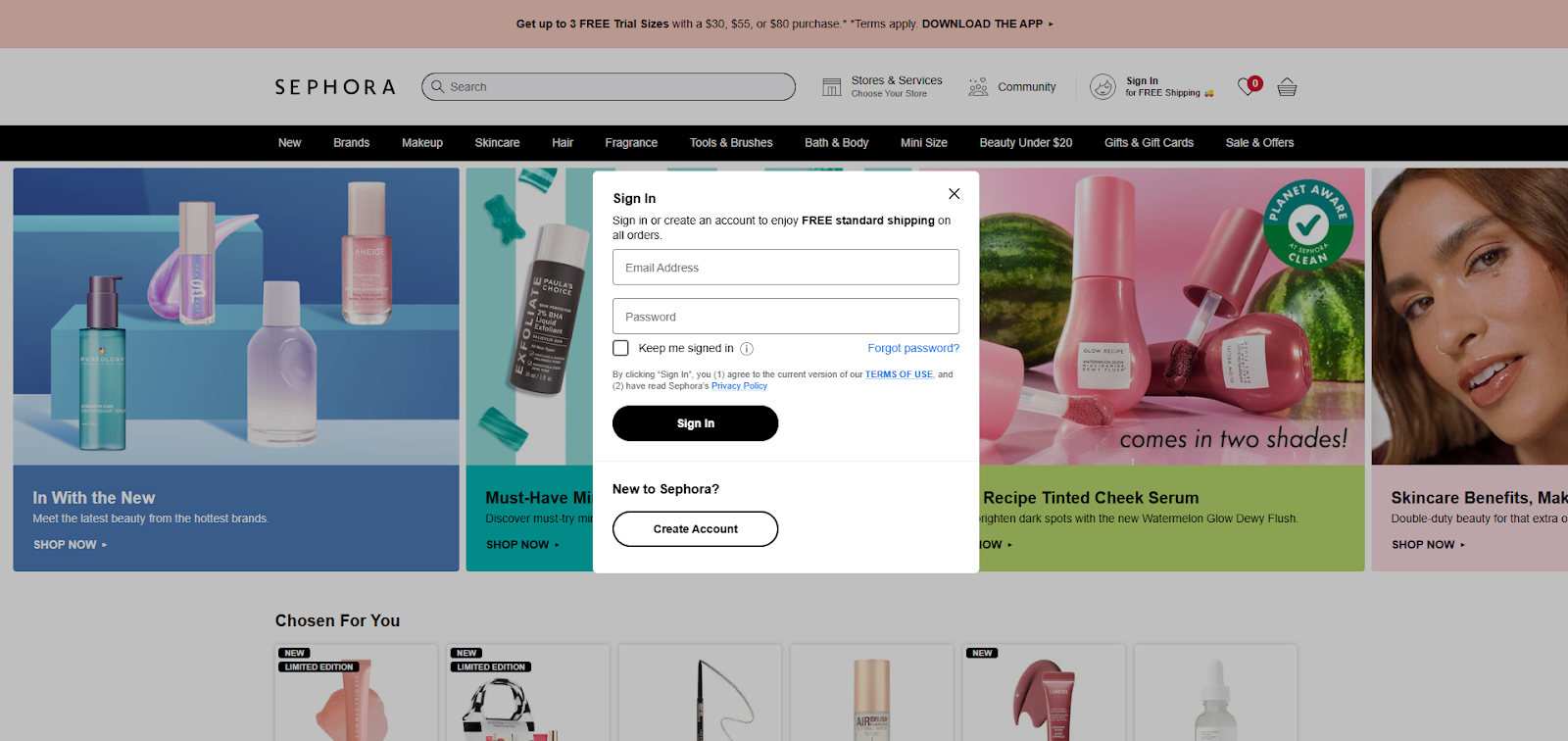
- Product Recommendations on Key Pages: Strategic recommendation widgets on the homepage, product detail pages, cart page, etc., keep the customer discovering relevant items. On the homepage, a “Just For You” carousel might blend affinity picks and trending items. On a product page, a “Pair With It” section might show items often bought together -for Sephora, viewing a foundation might show the matching primer and setting powder commonly bought with it. In the cart, a “Don’t forget these” suggestion could upsell accessories (e.g., makeup brushes) that others added before checkout.

Real-Time Relevance: As the user browses, you can update content in real-time. If they show interest in a certain brand or category in that session, the site can respond. If Jane clicks on several K-beauty products today, the site might instantly feature a K-beauty recommendations widget in the next page she visits. The goal is to seize on in-the-moment intent.
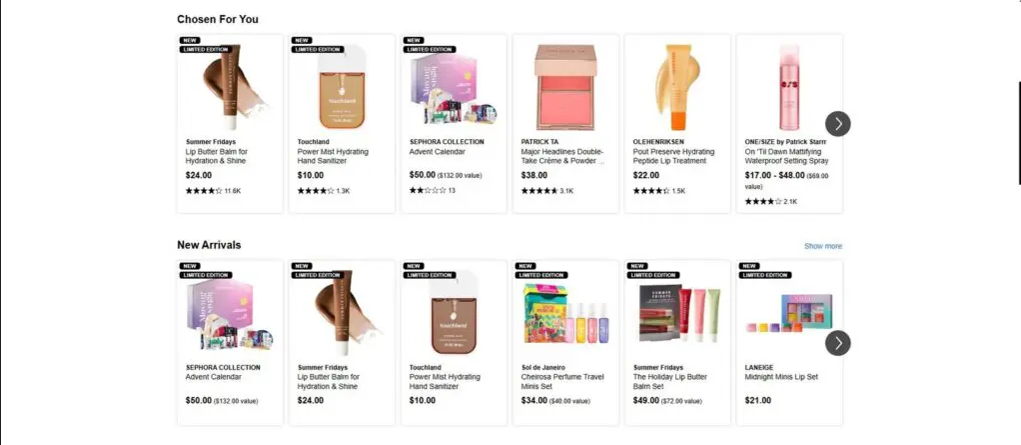
This level of relevance has a big impact. When customers feel like the site “gets” them, they explore more and buy more. And it’s not only about product pitches -it can be informational too. Sephora, for instance, knows whether you are a skincare enthusiast or a makeup newbie and can tailor educational content accordingly (such as linking to a skincare routine guide versus a makeup tutorial on the homepage). Everything aligns with the shopper’s profile.
Extending Personalization Beyond the Website
Personalization should not stop when the user leaves your website. Email and SMS are your follow-up champions -the means to re-engage and continue the journey off-site. The key is to carry the context from the website into these channels so the experience stays cohesive. Here’s how to do that:
Triggered Emails:
- Cart Abandonment: Remind users of items left in the cart with images, reviews, or limited-time offers.
- Browse Abandonment: Re-engage users who viewed products but didn’t purchase with personalized reminders and recommendations.
- Post-Purchase: Send tailored follow-ups with product care tips, tutorials, complementary items, or review requests.
Personalized Campaigns:
Segment newsletters and promos by interests (e.g., skincare fans get skincare deals, fragrance buyers get cologne offers). Include “Recommended for you” sections powered by real-time recommendations.
Relevant SMS:
Use concise, contextual messages with the user’s name and preferences. Send location-based offers or restock alerts, linking to personalized landing pages.
Unified Messaging & Deep Linking:
Keep messaging consistent across web, email, and SMS. Use deep links to bring users directly to relevant, personalized pages - ensuring a seamless journey.
Key Idea:
Treat email and SMS as extensions of your website, not separate campaigns - each touchpoint should feel like part of the same story.
Sephora’s Seamless Personalization in Action
- Unified Customer Profile:
Sephora’s Beauty Insider program gathers rich customer data - skin type, favorite brands, purchase history, and quiz results - enabling consistent personalization across channels. - Personalized Web Experience:
When Jane logs in, she sees tailored messages like “Recommended for you, Jane” and product carousels powered by her browsing habits and an AI-powered recommendation system. - Contextual Email Follow-up:
Later, she receives emails referencing viewed items (“Still thinking about Glow Serum X?”) plus related product suggestions and loyalty point reminders. Timely replenishment emails follow after purchases. - Immediate SMS Engagement:
Jane gets short, personalized texts with offers (“20% off your favorite GlowCo products”) and location-based invites for in-store samples, linking online and offline experiences. - Consistency Across Channels:
Messaging remains cohesive across web, email, and SMS - reinforcing the same themes and offers for a seamless, unified experience.
How to Implement Omnichannel Personalization With Intempt?
You might be thinking, “This sounds fantastic, but also a lot of moving parts… How do we actually do this?” Traditionally, marketers cobble together various tools: one for on-site personalization, another for product recommendations, another for email automation, maybe another for SMS -plus a customer data platform to tie data together (and let’s not even start on connecting in-store data!). Integrating and maintaining all that can be a nightmare -data silos, inconsistent segmentation, latency issues, high costs, you name it.
This is where an all-in-one growth platform like Intempt’s GrowthOS can be a game-changer. (Disclosure: that’s our platform, built from seeing these pains firsthand.) Intempt’s GrowthOS unifies website/app personalization, product recommendations, and cross-channel customer journeys, all in one place with the help of AI. Here’s how it simplifies the job and amplifies your capabilities:
Step 1: Unify Your Customer Data
Connect website, app, and catalog data inside Intempt’s GrowthOS CDP.
It consolidates data from your website, app, and eCommerce store into a single customer profile, giving you real-time insights and ensuring consistent personalization across channels.
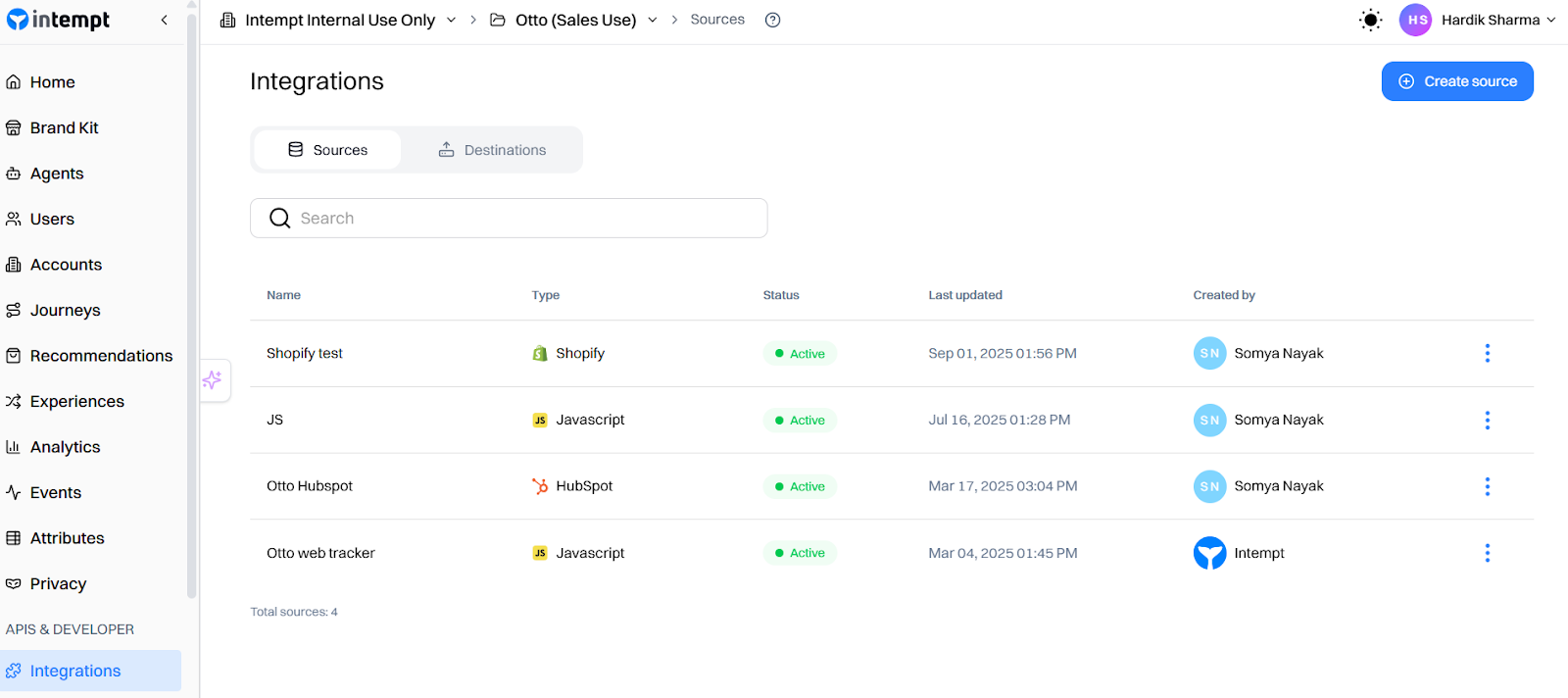
Step 2: Build Predictive Segments
Use AI-based segmentation (RFM, lifecycle stages, predicted churn/purchase).
Segments auto-refresh in real time, powering instant personalization rules. Customize, test, and adapt recommendations to align with your business goals, such as promoting high-inventory items or popular products.

Step 3: Activate Recommendations Onsite
Insert recommendation widgets across key pages:
- Homepage: “Just for You” carousels mixing affinity + trending.
- PDP: “Pair With It” (collaborative filtering).
- Cart: “Don’t forget these” (FBT + low-AOV upsells).
- Dynamic banners: Real-time responses to browsing (e.g., user views 3 K-beauty items → show “K-beauty trending now”).

Step 4: Extend personalization to email & SMS
Behavioral triggers:
- Cart abandonment → “Your favorites are almost gone.”
- Browse abandonment → “Still thinking about these?”
- Post-purchase → Care tips, tutorials, complementary products.
Segmented newsletters: Campaigns that highlight each user’s preferred category.
Personalized SMS: Time-sensitive, location-aware messages that link to personalized landing pages. All of this was made seamless with the help of our AI.
Step 5: Keep cross-channel consistency
Use deep links from email/SMS → personalized pages.
Maintain consistent offers, product sets, and creative themes across all channels.
For example, you could automatically trigger a personalized email when a customer becomes inactive, followed by an SMS reminder, enhancing customer engagement effortlessly. You can define with AI to make your work more easier.
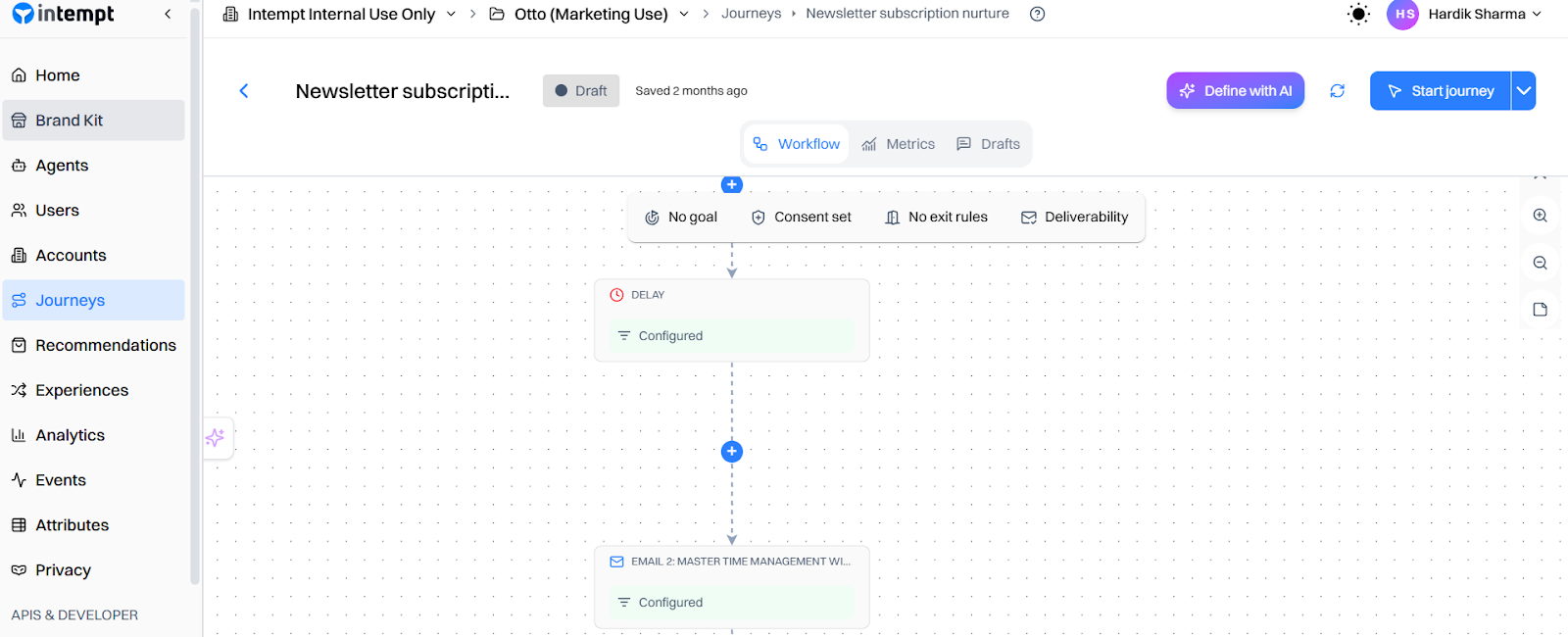
Conclusion: One Journey, One Customer (Make It Count)
Today’s eCommerce customer expects a personalized, cohesive experience. They don’t think in terms of channels -to them, interacting with your brand is one continuous relationship, whether it’s on your website, in their inbox, via text, or in a physical store.
By combining segment-based personalization (e.g., knowing who someone is, what they’ve done, and what they need) with smart catalog recommendations (offering what they’re most likely to want), you create relevance. By extending that relevance across channels with consistent messaging and timing, you create trust and convenience. The key is to start thinking holistically: break down the silos between your web experience and your messaging campaigns. Plan them together, fueled by the same customer data and logic.
So, next time you’re setting up an email campaign, ask: “What did this user just experience on our site, and what will they see when they click through?” Make sure all the pieces connect. With the right strategy (and the right platform to support you), you’ll turn disparate touchpoints into one harmonious journey -and your customers will notice the difference.
TL;DR
- Unify customer data (web + app + catalog) → single profile.
- Combine segment-based (who) + catalog-based (what) personalization.
- Activate in real time: on-site widgets, behavioral emails, SMS follow-ups.
- Keep messaging consistent across every touchpoint.
- Test for lift in engagement, repeat purchase rate, and LTV.
FAQs
1) How do I personalize if I don’t have full user data yet?
You can start with contextual cues (category viewed, referral source) and default to popularity-based recommendations. Gradually enrich segments as data accrues.
2) How do I keep email/SMS consistent with the website?
The best way is to use deep links pointing directly to personalized landing pages or product modules. Sync recommendation feeds and segment logic across all channels.
3) How do I avoid overwhelming new users?
Balance is the key. Use one personalized banner or carousel per page, not five. Prioritize relevance over quantity.
4) How can I measure impact?
Run A/B tests comparing personalized vs. generic experiences. Track conversion rate, RPV, and retention.
5) What about privacy and compliance?
Always remember, respect user consent, maintain GDPR/CCPA compliance, and only collect behavior necessary for personalization.
6) Do I need multiple tools for this?
No. Intempt’s GrowthOS unifies data, segmentation, recommendations, and omnichannel journeys in one platform. So, you only need one platform for every need.
FAQs
Can I trial Webflow before paying?
Sure! You can test out Webflow on our free plan where you can experiment with 2 projects. Your unhosted projects will have a two-page limit, but you can purchase a site plan on a per-project basis to unlock up to 100 static pages and additional CMS pages.
What is a project?
A project is a website that you build in Webflow. You can publish projects to a webflow.io staging subdomain for free, export the code on a paid plan, or add a site plan to connect your custom domain and unlock hosting features.
What can I white label?
Pro accounts can add their own logo to Client Billing forms and the Editor. Pro accounts can also remove references to Webflow in the source code and form submission emails, and hide the Webflow badge from their staging sites.
How much traffic can the hosting handle?
Webflow hosting scales automatically to handle millions of concurrent visits. All site plans serve sites through our Amazon's Cloudfront CDN and accelerated using Fastly, loading sites in milliseconds.
What kind of support does Webflow provide?
We offer fast email support to paid accounts and prioritized help for team accounts. Community support (forum.webflow.com) is available to free accounts.
How long does it take to learn Webflow?
If you're new to building websites, our video tutorials will get up and running quickly. If you already know concepts behind CSS and the box model, you will feel at home in Webflow.
Check out Growth Play Library ➡️
Get started free on GrowthOS ➡️
Book a growth call ➡️
.svg)
Sid Chaudhary
Founder & CEO
Looking for ways to grow faster?
Discover marketing workspace where you turn audiences into revenue.
Learn about IntemptYou might also like...
%20In-Depth%20Comparison.png)
Intempt v/s Klaviyo (2025): In-Depth Comparison
Marketers want seamless customer journeys, not a maze of rules and manual triggers. If the system feels like work, it’s not automation, it’s stress in a shiny UI. Klaviyo has long been the go-to for e-commerce platforms, powering email, SMS, and now even WhatsApp automation. But 2025 teams want more than AI that writes better subject lines; they want an AI comarketer that thinks ahead. In this comparison, we’ll explore Intempt v/s Klaviyo with a sharp focus on their Journeys to help you find out which one delivers true AI-powered orchestration rather than just automated messaging.

%20In-Depth%20Comparison.png)
Intempt vs VWO (2025): In-Depth Comparison
Marketers don’t just want to test ideas; they want to turn those ideas into real customer experiences. Simple A/B tests and standard conversion lifts were once the gold standard, but now they have become the ghost of the past, because in 2025, growth teams demand more. They want to personalize in real time, orchestrate intelligently, and connect experiment results to revenue outcomes.

%20In-Depth%20Comparison.png)
Intempt vs Mixpanel (2025): In-Depth Comparison
Marketers and product teams thrive on data, and let’s be honest, they hate it when it’s scattered across 2-3 different tools, buried in dashboards, and takes a ton of their time just to get a half-answer. Mixpanel has long been the gold standard for analytics, but 2025 teams want more than charts and funnels; they want action. They want orchestration, personalization, and a clear line from insight to revenue. In this comparison, we’re putting Intempt vs. Mixpanel under the microscope, feature by feature, insight by insight, to help you find the smarter and more future-ready analytics partner for your team.

Subscribe to The Full Stack Marketer 📈
Zero theory or mindset discussions here; just actionable marketing tactics that will grow revenue today.
.svg)













.svg)

.svg)





